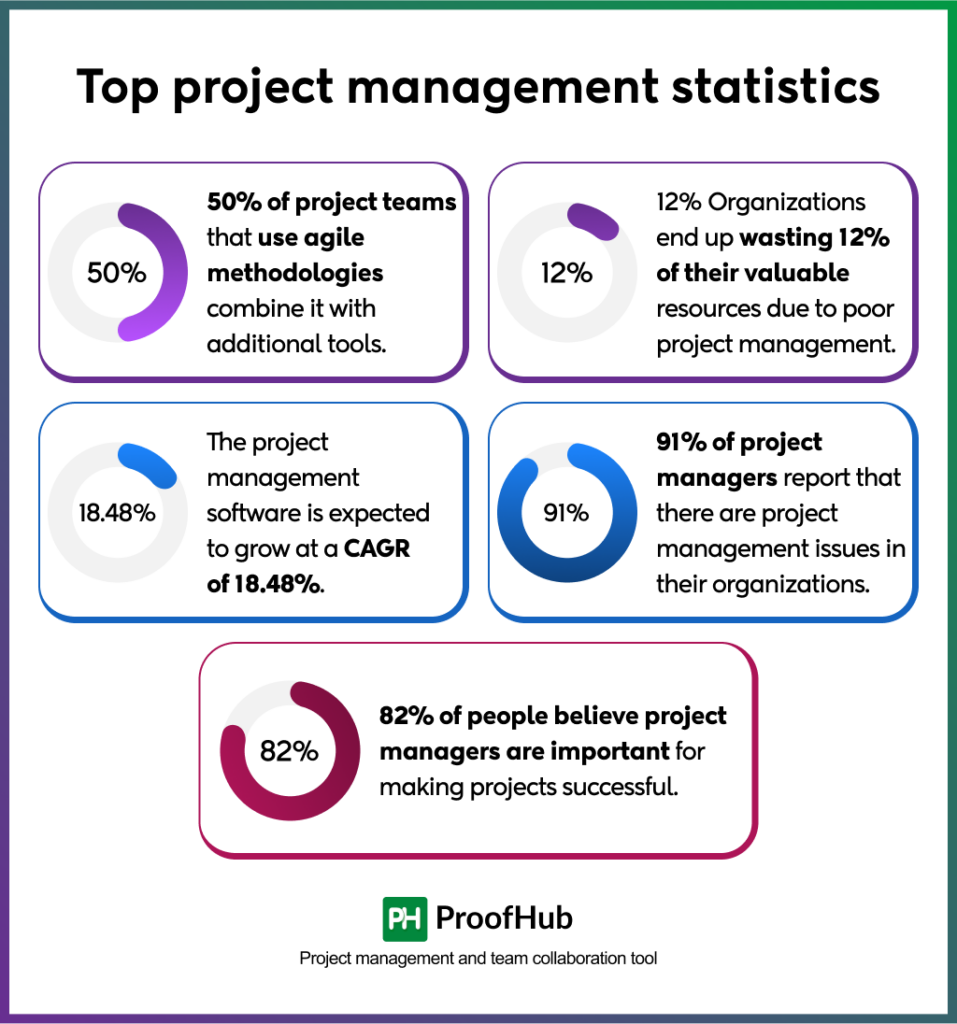Numbers have a way of cutting through the noise, revealing patterns, and guiding smarter decisions. Throughout my career, I’ve relied on data-backed insights to shape winning strategies – whether it’s optimizing campaigns or improving team collaboration. And when it comes to project management, the right statistics can be a significant asset.
A project manager’s responsibility is more than managing projects, setting deadlines, or tracking progress. You also need to navigate shifting priorities, tight budgets, and team dynamics.
If you’ve ever struggled with missed deadlines, inefficient workflows, or team burnout, you’re not alone. The truth is, understanding where projects fail – and why some succeed – can help project managers like you course-correct before things spiral out of control.
That’s exactly why I’ve put together 31 powerful project management statistics and trends that every manager should know. From software adoption trends to failure rates and career insights, these numbers offer a clear, data-driven perspective on what’s working (and what’s not) in today’s fast-paced project environment.
A Free guide to help you with proven ways to lead a project from start to finish, without confusion or jargon.

Let’s dive in and explore the key takeaways that can help you avoid pitfalls, improve efficiency, and achieve better project outcomes.
31 important project management statistics and trends in 2025
These project management trends and statistics will give you insights on what’s working, where teams struggle, and how things like remote work and new tools are shaping the industry. You can get a clear picture of what’s happening so you can plan smarter and stay ahead.
Top project management statistics
Before you dive into the full report, take a moment to go over some of the most important project management statistics and current trends.

- 50% of project teams that use agile methodologies combine it with additional tools.
- Organizations end up wasting 12% of their valuable resources due to poor project management.
- The project management software is expected to grow at a CAGR of 18.48%.
- 91% of project managers report that there are project management issues in their organizations.
- 82% of people believe project managers are important for making projects successful.
Project management software statistics
Project management software helps you streamline your workflows, improve collaboration, and boost productivity. The statistics below reveal how these tools impact businesses, from adoption rates to ROI. Let’s dive into the numbers shaping the future of project management software.
1. The project management software is expected to grow at a CAGR of 18.48%
This stat highlights the widespread adoption of project management tools across the globe. According to a report by Straits Research, the project management software market is experiencing rapid growth. With a value of USD 7.36 billion in 2023, it’s projected to soar to USD 15.06 billion by 2032, boasting a remarkable CAGR of 18.48% from 2024 to 2032.
2. Only 23% of organizations use a project management software
This project management statistic is in contrast to the first one. Despite the project management software market witnessing healthy growth, its adoption rates are still on the lower side. Only 23% of companies use it in any capacity. The rest are working with Excel, paper, or below-par tools. If you are among 77% who don’t use it then you know who to blame if your project fails!
3. Most used and requested features in digital PM software.
There are so many project management software today that offer an array of features to users these days. Capterra reports that file sharing, email integration, Gantt charts, project monitoring, time tracking, and project budget management are five of the most used features in project management software.
4. 54% of the workforce believes they would save more than 5 hours by using automation tools
A survey from Monday.com found that 54% of the workforce believes that by using tools that automate tasks, they would be more productive and efficient at work as it can help them save more than 5 hours at work. 24% of respondents found time-consuming, tedious data input to be the biggest time sucker at work. Over 70% said that they would like to use automation tools for routine and repetitive tasks.

5. PM software helps to improve team communication
Another crucial project management statistic that you cannot ignore. It is a fact that swift, transparent communication is one of the keys to successful project performance. Teams using project management software with inbuilt communication features have reported a 52% improvement in team communication, which has further improved transparency within the organization. 44% said that it improved the quality of the final product, and 38% said that it improved customer satisfaction.
6. High-performing teams use project management software
What is the secret behind the success of high-performing teams? A study conducted by PWC found that 77% of high-performing teams use good project management software that offers a wide variety of inbuilt features. These features help users to manage various aspects of work from a single platform rather than switching between various applications.
7. The US is the biggest market for project management software
SaaS tool makers eye the biggest market where they can sell their products in good numbers. Currently, the United States is the biggest market for this technology, with 29.6% of the market share. That said, China has shown a lot of promise as one of the leading markets with a projected growth of 7.4% in the next seven years.
8. PM software helps the average employee save 498 hours per year
Every business and every professional wants more time to do things, but many people struggle to meet deadlines and achieve the desired productivity. The project management success statistics show that workflow management software helps employees save 498 hours on average per year.
9. Many organizations consider investing in new software as expensive
Of course, investing in a new project management system will cost an organization some amount of money. 56% of organizations find new software costs too high. However, considering the crucial benefits of using such a tool for project teams and organizations, it can be said that it’s worth it.
Not all project management software solutions are expensive. ProofHub offers flat-rate pricing plans with unlimited users!
Sign up today and save BIG!
Project management failure statistics
Despite the best efforts of managers and teams, not all projects succeed. Missed deadlines, budget overruns, and scope creep continue to affect businesses. These failure statistics highlight the most common pitfalls and what organizations can do to improve their project success rates.
10. Organizations end up wasting 12% of their valuable resources due to poor project management
Wastage of valuable resources is something that startups and small companies cannot afford. Many project managers often complain about the time wasted on repetitive and tedious tasks. As a result, inefficient project management processes cause nearly 12% wastage of organizational resources. This can be brought down by adopting a proactive approach and smart project management.
11. IT project failure rates correspond heavily to project size
Interestingly, bigger budgets always aren’t better when it comes to project management. Rather, the higher the budget, the more the chances of the project failing. According to the Wellingtone State of project managemne report 2020, 57% of companies exceed their allocated budget, and projects with budgets of more than $1 million are 50% more likely to fail as compared to the ones with a budget of less than $350,000.
12. Lack of clear goals and vision leads to project failures
There can be many reasons for project failures, but the lack of clear goals and vision is the most common factor (37%). Project managers should use Gantt charts or Boards to have a clear visualization of their project and deliverables.
13. Confusion surrounding job roles & responsibilities is a potential hurdle to a project’s success
38% of organizations believe that vagueness surrounding job roles and responsibilities is the biggest obstacle to a project’s success. If you face a similar problem then you can use good work management software with an inbuilt task management tool, which will help you to create, allocate, and monitor tasks from a centralized location.

14. Rework is such a waste of time
Rework leads to time wastage and also is a big cause of project failure. 80% of respondents in a Geneca survey said that they spend half their time on rework, which leaves them with little time to work on other tasks at hand.

15. Many organizations don’t have access to real-time project KPIs
Wellingtone’s The State of Project Management Report (2020) states that despite companies facing immense pressure to manage projects on a greater scale, 54% of companies don’t have access to real-time project KPIs (key performance indicators). 25% of respondents in this report said they don’t have access to the right technology to collaborate on information projects in their business.
Project management career statistics
Project management is a growing and in-demand career, with opportunities expanding across industries. From salary trends to job growth projections, these statistics offer valuable insights for aspiring and experienced project managers looking to advance in their careers.
16. Most project managers are not happy with the technology they are using
If project managers are not happy with the technology they are using then how can you expect them to deliver the goods as expected? A study by Wellingtone in 2020 showed that only 35% of marketers were moderately or fully satisfied with the project management tools they were using. 52% of respondents reported dissatisfaction.
17. 82% of employees believe project managers are important for making projects successful
According to a KPMGxPMI project management survey, 82% of employees recognize project managers as crucial to success, highlighting their role in connecting business with project teams. Organizations are investing in young talent through training and certifications. While communication and teamwork skills are strong, there’s a need for improvement in handling challenges and mastering agile terminology and methodologies for better project outcomes.
18. The average salary of a project manager in the US is $96,360
Based on the data collected from anonymous PM employees in the US, a BuiltIn survey has reported that the average salary for a Project Manager in the US is $96,360. The average additional cash compensation for a Project Manager in the US is $11,684. The average total compensation for a Project Manager in the US is $108,044.
19. Stress is taking its toll on project managers
Managing multiple projects simultaneously and relentless pressure to meet deadlines can take its toll on even the most efficient project managers. Though perks are quite good, 1 in 5 project managers has admitted to considering leaving their job.
20. 91% of project managers report that there are project management issues in their organizations
Project management challenges are nearly universal, with 91% of managers struggling due to shifting teams, remote work, or extended leave. Worse, 85% feel overwhelmed by project pace and deadlines, highlighting the urgent need for better workflows, resource and project planning, and collaboration tools.
21. PMP certification helps managers earn more
Project managers with PMP certification earn 23% more in salaries as compared to those who are without it. So, get this certification, further your education, and achieve more financial growth than others.
22. Project management professionals are in high demand
A report by the Project Management Institute said that around 25 million new project management professionals will be required by 2030, and a loss of around USD 345 billion in global GDP is estimated by that time in case of a shortage of project management talent.
Project management industry statistics
The project management industry is evolving rapidly, driven by technology, changing work environments, and new methodologies. These statistics provide a snapshot of the industry’s current state, including market growth, trends, and future predictions.
23. More organizations have centralized PMOs
57% of organizations opt to use a centralized PMO, which is a testament to the increasing importance of project management and cross-project dependency management.
24. Agile project management approach boosts success, with 39% of users achieving a 75.4% project success rate
Agile project management significantly improves project success rates. The 2023 MPI Pulse of the Profession report shows that 39% of Agile users achieved a 75.4% project success rate, demonstrating the effectiveness of Agile and Scrum methodologies.
25. Most managers are managing multiple projects
Only 15% of project managers focus on a single project at a time. They are lucky ones indeed! Because most managers are managing multiple projects at the same time; some of them are handling five or even up to ten projects. Considering such a hectic workload, project managers can get overly stressed and easily lose control over projects and teams, leading to project delays or even worse, project failure. Using a powerful work management and team collaboration tool like ProofHub can help project managers have a bird’s-eye view of every project they are working on.
26. Good project management means fewer costs to organizations
Every business, small or large, wants to keep its operating costs down while generating maximum revenue. Organizations that invest in tried and tested project management practices end up spending 28x less money as they can complete their strategic initiatives successfully. Capterra’s recent market research report discovered that a PM tool helps organizations to better estimate a timeline, which results in lower costs to companies.
27. Hybrid project delivery is the most common approach
A 2019 Pulse survey revealed that around 60% of project managers are using the Hybrid project delivery approach, which is a blend of Waterfall and Agile methods. Another revealing fact is that the hybrid delivery approach is preferred by project managers at all levels of experience and not just seasoned professionals.

28. Most project teams are compact
Project managers find it easier to manage small project teams than larger ones. The good news is that 40% of project teams comprise 6 to 10 people. 30.5% have more than 10 people; another 30.5% are composed of 1-5 people. Having too many people to manage can make it challenging for project managers to maintain team engagement and accountability at the same time.
29. Many organizations are providing project management training
Project management is a growing and promising career option and many organizations recognize this fact. A PMI report from 2021 has shown that 61% of companies provide some kind of project management training. In the same report, around 47% of companies have said that they have defined specific career paths for project managers.
30. 50% of project teams that use agile methodologies combine it with additional tools
Half of project teams using agile methodologies integrate additional tools to streamline their workflows. Many combine agile with waterfall project management or other methods suited to the project. So, its important that you stay informed about the best tools, like Kanban boards, to optimize productivity.
31. Projects are 2.5 times more successful when PM practices are implemented
Projects with structured PM approaches are 2.5 times more successful, ensuring better planning, project execution, and outcomes. Strong PM frameworks reduce risks, enhance collaboration, and drive efficiency, resulting in consistent success.
Conclusion
As we step into 2025, the latest project management statistics reveal an important piece of information about recent developments shaping this fast-growing industry. For project managers and organizations, these insights are more than just numbers- they are essential for making informed decisions and building effectiveness in strategies.
Efficient work management and team collaboration are the two primary key ingredients to project success. That’s where ProofHub truly shines. Designed with simplicity and efficiency in mind, ProofHub keeps your teams organized, boosts productivity and ensures seamless collaboration- all in one place.
Why settle for anything less when you can have an all-in-one tool that streamlines workflows, centralizes tasks, and manages everything that drives your project’s success? Plus, with no per-user fee, you get unlimited team access without worrying about rising costs as your team grows.
FAQs
Why are project management statistics important?
Project management statistics are important because they represent an accurate picture of the state of project management across different industries across the globe.
What are some top project management tools?
Some of the best project management tools available today are ProofHub, Wrike, Basecamp, Trello, and Teamwork. Of all these tools, ProofHub offers the most value for its price.
What are five major project management variables?
Five major project management variables are – time, scope, cost, quality, and risk.
How can project managers use statistics to improve their team’s performance?
Project managers can use statistics to track productivity, identify bottlenecks, and optimize workflows. Data-driven insights can help you set realistic goals, improve resource allocation, and enhance team collaboration, boosting efficiency and success rates.
How can project management statistics help in decision-making?
Project management statistics provide factual insights into timelines, budgets, risks, and resource utilization. They can help you make informed decisions, anticipate challenges, and implement strategies to improve project outcomes while minimizing risks.
Why do you need to know project management statistics?
Knowing project management statistics can help you understand industry trends, improve planning, and make data-backed decisions. It enhances efficiency, reduces uncertainties, and ensures projects stay on track, resulting in better comprehensive management.

